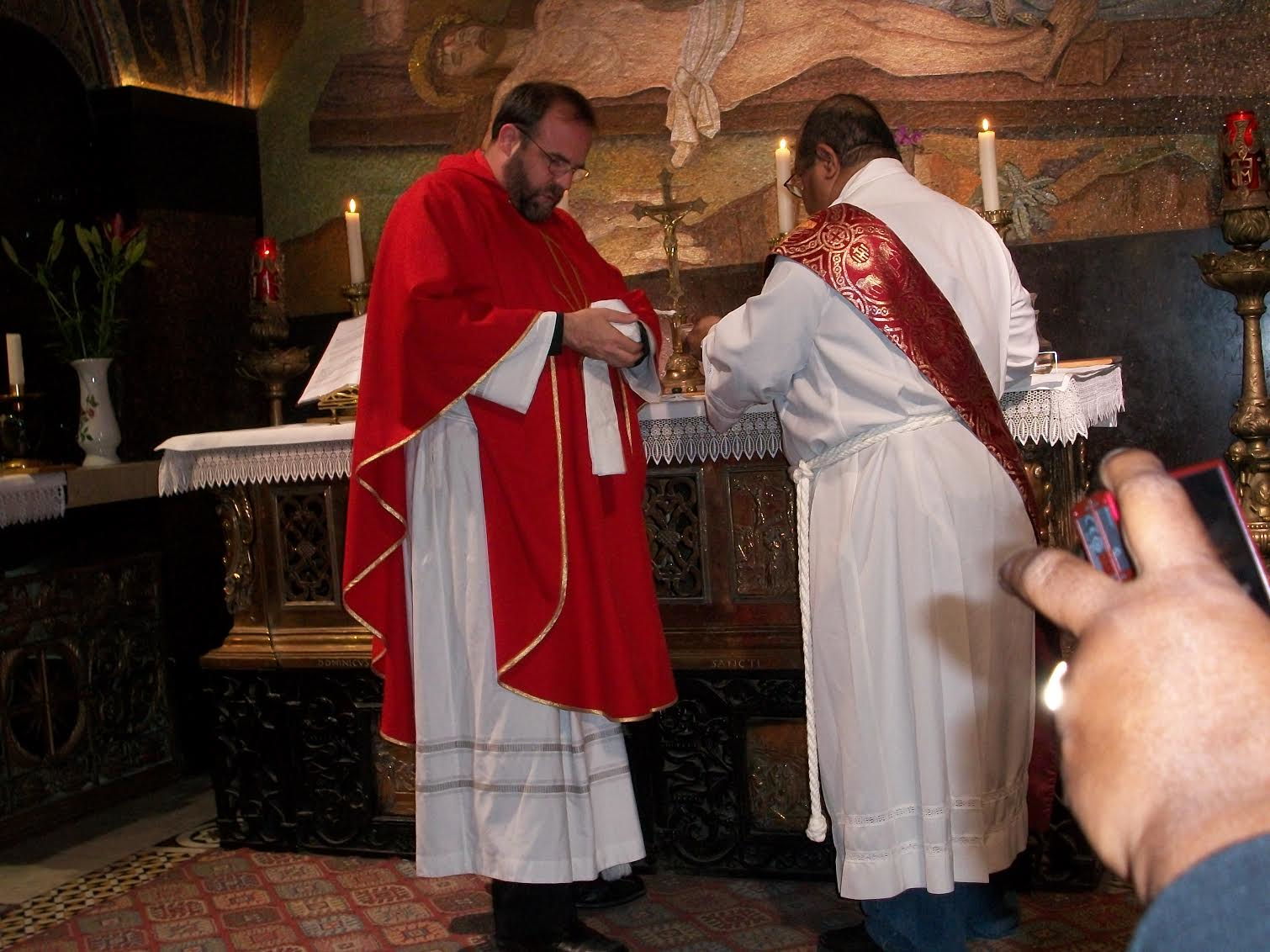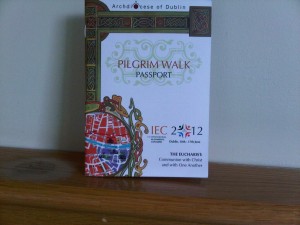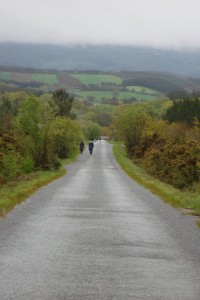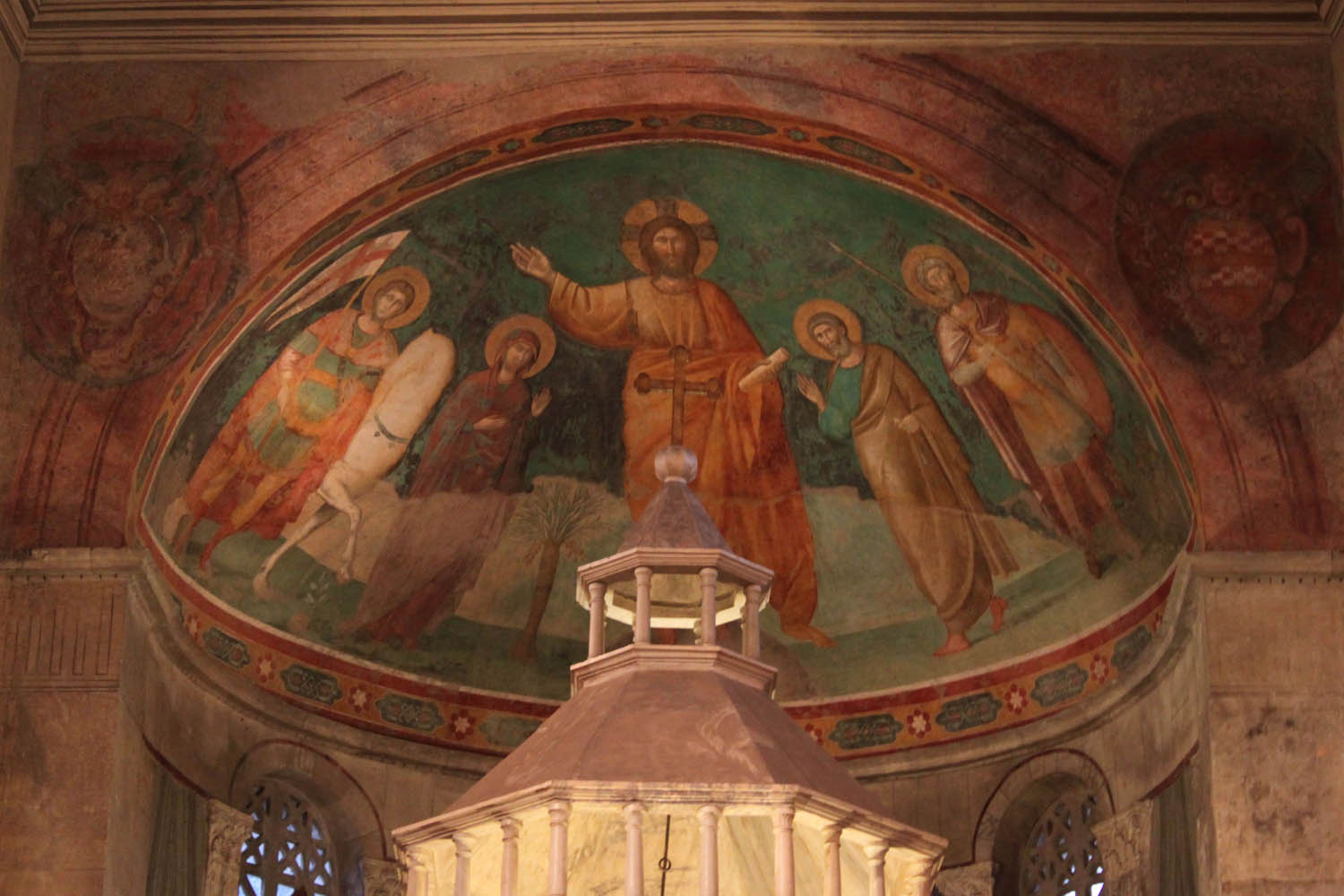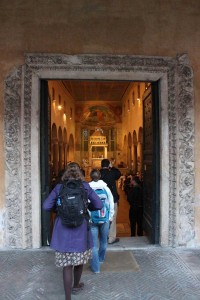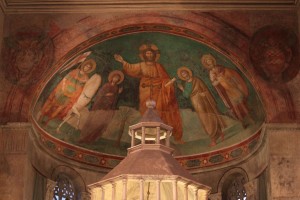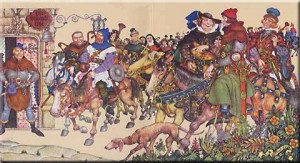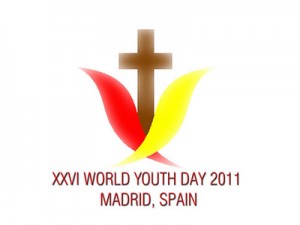This coming March (19th – 30th), Patrick Coffin (of Catholic Answers) and I will lead a pilgrimage to the Holy Land. You are invited to come! Details are available here: Catholic Holy Land Pilgrimage.
As I prepare for that trip I recall that one of the greatest moments in my entire life, and certainly in my life as a priest, was celebrating Holy Mass in the Church of the Holy Sepulchre, at the Latin altar on Golgotha, the very site of the crucifixion. Not far away, just at the other end of the Church was the site of the resurrection. I was overwhelmed to think I was at the very site to which every Mass points.
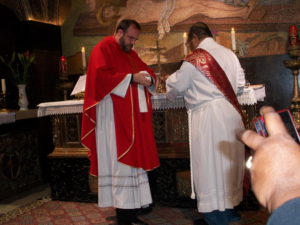 The site of the crucifixion and burial of the Lord is well documented both archaeologically and historically. A large church was built over the site in the Byzantine period (the period just after the Edict of Constantine). Parts of the current church date back to the 7th century. At one end of the church is a tall hill, covered over by the church structure but reachable by steep stairs. At the top of the platform high up in the church, the rock face of Calvary is exposed and there is a hole (under the Orthodox altar) through which pilgrims can reach to touch the rocky spot where the cross stood. Just six feet to the right of that is the Roman Catholic (Latin) altar where I was privileged to celebrate Mass with my parish group (see photo at right).
The site of the crucifixion and burial of the Lord is well documented both archaeologically and historically. A large church was built over the site in the Byzantine period (the period just after the Edict of Constantine). Parts of the current church date back to the 7th century. At one end of the church is a tall hill, covered over by the church structure but reachable by steep stairs. At the top of the platform high up in the church, the rock face of Calvary is exposed and there is a hole (under the Orthodox altar) through which pilgrims can reach to touch the rocky spot where the cross stood. Just six feet to the right of that is the Roman Catholic (Latin) altar where I was privileged to celebrate Mass with my parish group (see photo at right).
A pilgrimage is not a vacation; it is not a mere trip—it is a journey in faith. It is designed to grow our faith and confirm it. We pray and celebrate Mass every single day. Each day we visit several sites that we have always heard about and read in the Scriptures, both the Old and New Testaments.
There is nothing like walking through the streets of ancient Capernaum, standing in the ruins of the synagogue where the Bread of Life discourse was given. What an amazing experience to sail the Sea of Galilee, or go to Nazareth and look into the archeological remains of the simple home where the Angel Gabriel visited Mary! What a view from Mt. Tabor down into the Jezreel Valley, the “Valley of Armageddon”! It is nothing short of glorious to be in the hill country of Judea and walk the steep hill up to the Church of the Visitation. Jericho, too, never fails to amaze. And what an experience to go back up to Jerusalem and sit on the Mount of Olives, looking over the Kidron Valley! Ponder that our Lord sat here as well, looking down on ancient Jerusalem. Yes, what a view! Imagine spending time in quiet prayer in the Garden at Gethsemane and thinking of that difficult night for our Lord more than 2,000 years ago.
The Holy Land—there is just nothing like it! Even though I’ve been there twice, I still can’t wait to go back.
Another strong impression from my previous visits to the Holy Land is how very Catholic it is. To go to the many sites is to “enter” the Catholic Church, at least physically. At almost every site, a Catholic church dominates the scene: at Capernaum (where the loaves and fishes were multiplied), at Cana, in Nazareth, on the Mount of the Beatitudes, on Mt. Tabor. In all these places there is only one church building, and it is a Catholic church building. In Jerusalem, too, most of the sites have a Catholic church on or adjacent to the site: The Mount of Olives, Dominus Flevit (where the Lord wept over Jerusalem), the Garden of Gethsemane, the house of Caiaphas, the place of the trial before Pontius Pilate.
I wonder what Protestant Christians experience as they visit site after site and see, once again, a Catholic church (Blessed Sacrament and all) either at the site or literally on top of it. And in the few sites where the church is not Catholic (Bethlehem and Holy Sepulchre) it is the Orthodox who oversee it. In both cases there is a strong Roman Catholic presence. I do not intend to convey a triumphalist attitude, but only to say that I feel very proud and happy to be a Catholic when I’m in the Holy Land. Almost every site is fundamentally a Catholic site.
Gratitude for the Franciscans – We ought to be very grateful to the Franciscans of the Holy Land for the wonderful care they provide for these holy sites. They have been most kind to the groups I have led, allowing us to say Mass as well. At each site they are hospitable to people of every faith. They keep the churches clean and the holy sites in good repair. They have also accommodated archeological research and have been most helpful to the process of verifying the authenticity of the sites.
Please consider visiting the Holy Land. The pilgrimage that Patrick Coffin and I will lead takes place early next year (March 19th – 30th 2017). We will visit all the crucial sites: in Galilee, up north, in Jerusalem, in Bethlehem, in Jericho, and the Dead Sea down to the south. If you’ve never been before, I assure you that your life will be changed as all the sites you have always heard of are suddenly right before your very eyes.
More information on the trip is available here: Catholic Holy Land Pilgrimage.
Patrick Coffin put a video invitation together that you can view here:

